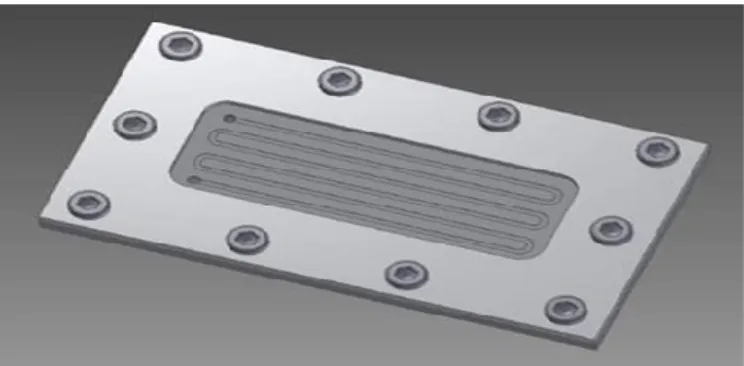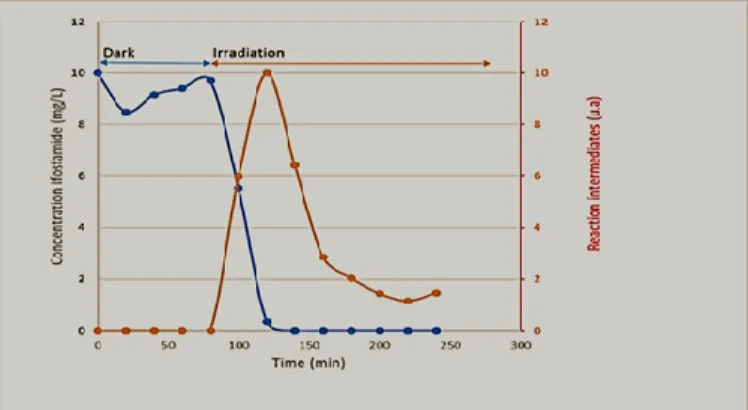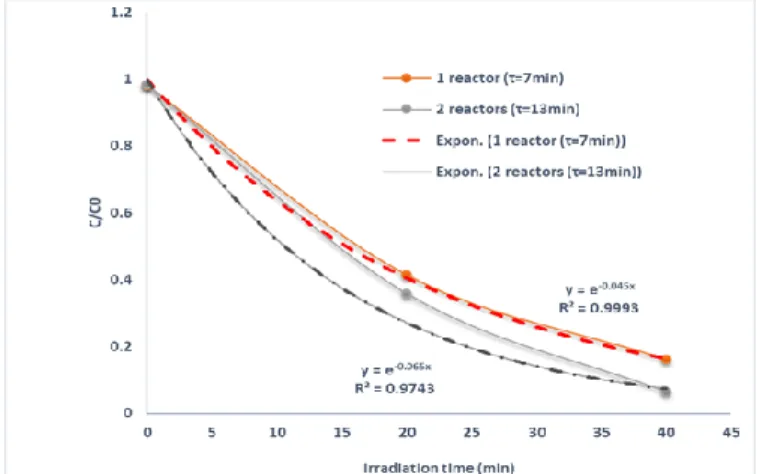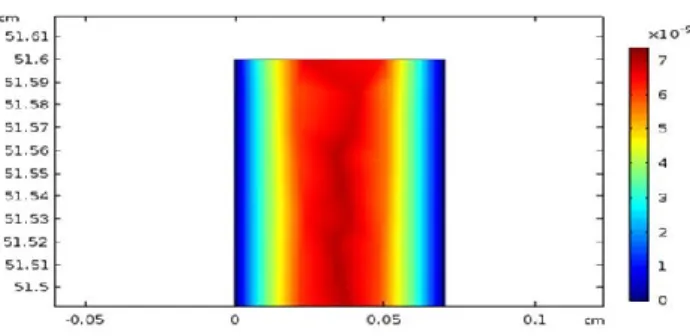HAL Id: hal-02017621
https://hal.univ-lorraine.fr/hal-02017621
Submitted on 26 Feb 2019HAL is a multi-disciplinary open access
archive for the deposit and dissemination of sci-entific research documents, whether they are pub-lished or not. The documents may come from teaching and research institutions in France or abroad, or from public or private research centers.
L’archive ouverte pluridisciplinaire HAL, est destinée au dépôt et à la diffusion de documents scientifiques de niveau recherche, publiés ou non, émanant des établissements d’enseignement et de recherche français ou étrangers, des laboratoires publics ou privés.
famide in a microchannel and simulation
Serge Corbel, Florian Donat, Raphaël Schneider
To cite this version:
Serge Corbel, Florian Donat, Raphaël Schneider. Kinetic study of photocatalytic degradation of Ifos famide in a microchannel and simulation. SDRP Journal of Nanotechnology & Material Science, Sift Desk, 2019, 2 (1), pp.75-82. �10.25177/jnms.2.1.ra.452�. �hal-02017621�
Received Date: 17th Jan 2019
Accepted Date: 06th Feb 2019
Published Date:08th Feb 2019
Dr. Serge Corbel, Dr. Florian Donat, Prof. Raphaël Schneider
Université de Lorraine, Laboratoire Réactions et Génie des Procédés (LRGP), UMR 7274, CNRS, 1 rue Grandville, BP 20451, 54001 Nancy Cedex, France
CORRESPONDENCE AUTHOR
Dr. Serge Corbel,
Telephone: +33 3 72 74 38 73; E-mail: serge.corbel@univ-lorraine.fr
CITATION
Serge Corbel et al., Kinetic study of photocatalytic degradation of Ifos famide in a microchannel and simula-tion(2019)SDRP Journal of Nanotechnology & Material Science 2(1)
Copy rights: © This is an Open access article distributed under the terms of International License.
ABSTRACT
Among the possible solutions for the intensification of photocatalytic reactions, the use of microreactors is emerging. Such an approach was applied to the photodegradation of Ifosfamide in a flow microreac-tor with an immobilized catalyst composed of ZnO sensitized with CuInZnxS2+x quantum dots. The conversion yield at a low flow rate was investigated. A computational flow simulation allows to determine an apparent constant rate and the diffusion coefficient towards the photocatalyst surface. Photocatalytic degradation of Ifosfamide can be fitted by the Lang-muir-Hinshelwood model. The Sherwood number and the average value of Damköhler show that the photocatalytic reaction under our experimental condi-tions is limited by the mass transfer.
Keywords: Photocatalysis, Microreactor, Kinetics,
Zinc Oxyde, Quantum Dots, Diffusion coefficient.
INTRODUCTION
Advanced oxidation processes and especially photo-catalysis are of high interest for the decontamination of water containing pollutants as hospital effluents
[1,2]. Heterogeneous photocatalysts employed in a tubular reactor enable the control over reactivity and selectivity [3]. Traditionally, photochemical reactors are operated in batch mode. This configuration leads to a non-uniform distribution of UV light and a mass transfer limitation due to a slow diffusion.
Among the possible solutions for the intensification of photocatalytic reactions, the use of microreactors is emerging [4,5]. Microreactors with channel dimen-sions of a few hundred microns exhibit larger surface to volume ratio compared to classic reactors [6] and thus enable optimum utilization of incident radiation [7]. The observed reaction rate is at least one order of magnitude higher than that observed in conventional reactors [8].
Zinc oxide (ZnO) has been widely investigated over the last ten years as photocatalyst and has been demonstrated to be of high potential [9]. However, ZnO suffers from two main drawbacks. First, due to its wide bandgap energy (Eg = 3.3 eV) [10]. ZnO can only be activated by light with a wavelength lower than ca. 380 nm to trigger the electron-hole
separa-Kinetic study of photocatalytic degradation of Ifos famide
in a microchannel and simulation
SDRP Journal of Nanotechnology & Material Science (ISSN: 2574-1888)
tion. Second, ZnO exhibits a low quantum efficiency due to the fast recombination of photo generated charge carriers (electrons and holes).
In recent reports, our group demonstrated the high photocatalytic activity either under simulated solar light or under visible light irradiation of doped- or QDs-sensitized metal oxides like ZnO or TiO2 [11-14]. The developed photocatalysts were demonstrated to have a high activity for the degradation of dyes like Orange II dye or drugs like salicylic acid. Another interesting application is in the field of health with Ifosfamide (IFOS) as an anti-tumor agent [15]. It is a persistent molecule that is difficult to degrade by tra-ditional methods and whose degradation leads to the production of intermediate products.
Photocatalysis is an interesting alternative for the degradation of IFOS but has only scarcely be investi-gated. OH radicals are the dominant species for the oxidation of IFOS and de-chlorination is the first step in the degradation of the photocatalytic oxidation pro-cess [16].
In this paper, the photocatalytic degradation of IFOS using a CuInZnxS2+x QDs (ZCIS) sensitized ZnO pho-tocatalyst immobilized in a microchannel was investi-gated under artificial solar irradiation. Our objective is to demonstrate the interest of microreactors for the kinetic study of photocatalytic reactions. The degra-dation of IFOS under solar irradiation (4 mW/cm2) was carried out using a thin layer of catalyst ZnO/ ZCIS deposited in a microchannel. In these condi-tions, it was possible to initiate and follow the photo-catalytic reaction. Degradation of IFOS can be fitted by the Langmuir-Hinshelwood model and external diffusion can be characterized by Sherwood (Sh) and Damköhler (Da) numbers.
2. MATERIALS AND METHODS
Previously, several microchannel reactors have been tested [17-20] in order to determine the best design of microreactors. The one tested in this research is com-posed of a microchannel with a serpentine shape en-graved in a stainless steel support. Figure 1 shows the shape of the microchannel covered by a rectangular glass.
Figure 1. Design of the microreactor with a
serpen-tine microchannel shape with a length of 516 mm.
The fluid flows into the rectangular section of the channel which is 1.5 mm wide, 0.7 mm deep and 516 mm long. The characteristics of the channel geometry and flow are shown in Table 1. At a flow rate of 5 mL/h, the space time is 390s experimentally meas-ured by the crossing time of a bubble between the inlet and the outlet of the microreactor. We have also measured the residence time distribution (RTD) to characterize the reactor. Experiments were realized with the injection of Blue Methylene tracer and ab-sorption of the solution at the outlet. A mean resi-dence time equal to 393s was found which is very close to the observed experimental space time. There was no stagnating zone between catalyst and flow region. Since the Reynolds number is about 1, the flow condition inside the microeactor channel is a laminar flow.
Table 1 - Geometric and flow characteristics of the channel at 5 mL/h. Width w
(mm) depth h (mm) Length L (mm) Volume V (mm3) Space time t p (s)
Average- Mean velocity
residence time u (mm/s) τ (s) Re number
2.1. Photocatalytic composite
Metal oxides such as ZnO have a wide band gap (3,24 eV) which limits its absorption to the UV re-gion. In order to improve the photocatalytic activity, we combined the ZnO semiconductor with ZCIS to form the ZnO/ZCIS composite photocatalyst. Among the good properties of this composite, there is a sepa-ration of the charges (e, h+) in order to prevent their recombination [9]. ZnO/ZCIS is an ideal candidate because of its low band gap (2.1 eV) and its low tox-icity.
The ZnO/ZCIS photocatalyst was deposited at the bottom of the micro-channel reactor. The amount of deposit was determined by weighing the dried reactor before and after the deposition. Several experiments were performed to determine the minimal mass with-out limitation of the production of reactive sites. An optimal mass of 40 mg was found. No differences of the conversion were observed with a variation of the concentration above this value.
2.2. Photocatalysis experiments
IFOS solution with an initial concentration varying from 2.5 to 10 mg/L was injected by means of a sy-ringe pump through the microreactor with a constant inlet flow rate of 5 mL/h. Even without irradiation, IFOS is adsorbed on photocatalyst when the flow is crossing the channel, which may result in a decrease of the solution concentration. To take into account this effect, we carried out the photodegradation reac-tion after waiting for 2 h in the dark in order to reach the adsorption equilibrium.
An artificial solar irradiation with Neon, JBL Solar Color T8 15W, was used. The intensity light was measured with a radiometer below the glass cover and just above the photocatalyst. A value of 4.0 mW cm-² was found.
During the step of irradiation, a sample was with-drawn after regular time intervals at the outlet of the microreactor. The solution of the sample was centri-fuged at 15, 000 rpm for 2 min and then injected into
an HPLC in order to determine the output concentra-tion of IFOS and then the conversion yield. The sig-nal at 485 nm was used to evaluate the conversion of IFOS.
3. EXPERIMENTAL RESULTS
3.1. Adsorption and degradation of Ifosfamide
Under dark conditions, the equilibrium of the adsorp-tion of IFOS was achieved after 90 minutes. The con-centration profile obtained from the kinetic experi-ments using the microreactor with ZnO/ZCIS and initial concentration of 10 mg/L is represented on Figure 2. After the beginning of irradiation (t = 90min), there is a fast degradation which occurs in less than 30 minutes. Nevertheless, there is a simulta-neous degradation of secondary products for a longer time of 50 minutes.
Figure 2. Degradation of Ifosfamide and the
second-ary products in microreactor under solar light ; Irradi-ation after 90 minutes in the dark (initial time in the dark).
3.2. Influence of the residence time on the conver-sion yield
In this case, the experiments were realized at the same flow rate of 5mL/h and C0=10mg/L; the resi-dence time τ is adjusted by changing the reactive vol-ume of the microchannel. This was achieved by con-necting several microreactors in series. The final phase was a development of an integrated system with several microreactors. This makes it possible to determine the improvement due to a longer reaction time. The Figure 3 illustrates the variation of the
con-version yield as a function of irradiation time in the case of two reactors in series. After reaching the ad-sorption–desorption equilibrium in the dark during 90 min (Figure 1), C/C0 equals 1 and the irradiation time is started (t=0). A gradual decrease of the concentra-tion of Ifosfamide is observed as a funcconcentra-tion of the irradiation time (Figure 3). The efficiencies of Ifosfamide degradation by ZCis is determined quanti-tatively using the pseudo-first-order model C/C0 =exp (−kap t), where kap is the apparent rate constant (min−1) and C0 and C are the concentrations of Ifosfamide at time 0 and t, respectively. The rate con-stants kap determined for the degradation of the IFOS solution are found by R-squared values on the trend lines; the values are 0.045 (R2=0.9993) and 0.065 min−1 (R2=0.9743) for one reactor and two reactors in series, respectively.
Figure 3. Photocatalytic degradation of Ifosfamide
under solar irradiation (light intensity I=4 mW/cm2) ; flow rate Q=5mL/h ; C0=10mg/L; Influence of the space time when connecting several microreactors in series.
3.3. Influence of the initial concentration of Ifosfamide
On the other hand, the effect of the initial IFOS con-centration C0 on the photocatalytic degradation by varying the concentration between 2.5 to 10 mg/L. The experiments have been performed with one reac-tor (516 mm). As can be seen in Figure 4, the initial slope of the curve is almost the same but a significant change occurs on the final conversion yield. It in-creases when the initial concentration of the pollutant decreases.
Figure 4. Influence of the initial concentration of
Ifosfamide on the degradation; Flow rate = 5 mL/h ; I= 4 mW/cm2.
There is a decrease in the value of the rate constant until the equalization of the adsorption–desorption and kinetic rates. After 30 min of irradiation, the per-centage of IFOS concentration levelled off due to the weak amount of concentration remaining in solution and equilibrium rates.
3.4. Modeling with COMSOL Multiphysics
In order to predict the time required for the degrada-tion of IFOS and thus the reactor length needed, the IFOS concentration to the reactive surface Cs was calculated by the Computational fluid dynamics method. The schematic profile in the channel domain is shown in Figure 5.
Figure 5. Schematic profile in the channel domain
The model takes into account the convection-diffusion coupling occurring with the flow and the deposited photocatalyst. We introduced an equation reaction rate r at the photocatalytic surface and a mean value of the outlet concentration was used to estimate the fraction of IFOS remaining (C/C0).
Photocatalytic degradation rate of IFOS can be fitted by the Langmuir-Hinshelwood model with the as-sumption that the photocatalytic degradation occurs between the substrate and the adsorbed reactive spe-cies on the photocatalytic surface.
r = k K C/(1+K C) (1)
Where k the intrinsic reaction rate constant and K the adsorption constant. By adjustment of the model with experimental values, we determined these two param-eters: k=2.98 10-4 mol m-3 s-1 and K=4000 m3 mol-1.
A Newtonian incompressible flow was adopted to simulate the aqueous solution with a laminar flow distribution in the microchannel. The surface concen-tration Cs is calculated by the material balance for the surface, including diffusion and a reaction rate.
(2)
where Cs is the surface concentration of IFOS in mol m-2 and r the surface reaction rate. In the model, the surface reaction rate r is considered as a negative boundary flux.
The transport in the bulk of the channel is described by a convection-diffusion equation:
(3)
In the above equation, D denotes the isotropic diffu-sion coefficient of IFOS in aqueous solution, and u the flow velocity. In this case, the velocity u(x) in the perpendicular direction (width of the microchannel)
equals 0 while the velocity in the parallel direction u (y) of the active surface (length of the microchannel) has a Gaussian distribution due to laminar flow distri-bution. The value of Reynolds number Re equals 1.3 which corresponds to a laminar flow.
At time t =1 minute, Figure 6 illustrates the convec-tive flow (component y) near the output of the micro-reactor, and Figure 7 shows the distribution of the diffusive flux inside the microchannel at the same time. There is clearly a concentration gradient be-tween the reaction medium and the catalytic surface corresponding to a limiting thickness of the diffusion layer about 0.2 mm.
Figure 6. Convective flux inside the microchannel with laminar flow (Re=1.3); flow rate Q=5mL/h.
Figure 7. Diffusive flux inside the microchannel and
concentration gradient on the right side; flow rate Q=5mL/h.
3.4.1 Kinetic modeling and comparison with experi-mental results
As can be seen on Figure 8, there is a good agreement between experience and model. In our conditions of 5 mL/h, 70 % of conversion was reached in 20 minutes (C/C0=0.3).
Figure 8. Comparison of experimental result and
modeling based on Langmuir-Hinshelwood kinetic parameters Influence of the diffusion coefficient IFOS towards the photocatalyst; flow rate Q=5mL/h.
A small variation of the conversion rate was observed by varying the diffusion coefficient between 5. 10-10 and 10-9 m2 s-1. The adjustment of the model with the experimental results allows to evaluate the diffusion coefficient of IFOS towards the photocatalyst at about 1. 10-9 m2 s-1. This value corresponds to that found in the literature for persistent pollutants like Chlorophe-nols. For example, Martins et al. [21] find a value of 1. 10- 9 m2 s-1 for the self-diffusion coefficient of 2-chlorophenol in water at 298K in a bulk reactor. Fig-ure 9 shows the diffusion flux which has decreased slightly with the reaction time and that corresponds to the change of concentration gradient over time. The diffusion flux to the catalytic wall compensates for the consumption of the reactants during the passage time in the reactor. In the case of total length of 2m and in our experimental conditions, a diffusion time is evaluated to about 250s.
Figure 9. Diffusive flux along the photocatalytic
sur-face and influence of the reaction time during the flow in the reactor.
3.4.2 Mass transport toward catalytic surface The Sherwood number is a function of the hydraulic channel diameter dh, the diffusion coefficient D and the mass transfer coefficient kd. The hydraulic diame-ter and the diffusion coefficient are constant whereas the mass transfer coefficient is a function of the con-centration of IFOS. As fluid flows along the channel in y-direction, the concentration gradient in x-direction due to the photocatalytic reactions leads to a mass transfer characterized by the mass transfer coef-ficient kd = Sh*dh/D.
In the Figure 10, Sherwood number is plotted versus coordinate y at a given time (t=20 min). Based on the results of Figure 10, one can estimate the value of Sh number around 1.45 which is in agreement with pre-vious study [20] but slightly lower than the value of 6 found previously.
Figure 10. Sherwood number along the catalytic
sur-face with a length of 200 cm.
From the value of Sherwood number, we deduce a mass transfer kd=7.6 10-6 m s-1.
To evaluate the limitation by mass transfer we used the number of Damköhler Da which represents the ratio between the rate of reaction and the rate of trans-fer [17].
Da=k/(kd*a/K) (4)
In which a is the specific area = Catalytic surface / Volume of microchannel. The value of Da around
100 shows that the rate of reaction under our experi-mental conditions is greater than the transfer of mat-ter and therefore the rate of transfer limits the photo-catalytic reaction.
4. CONCLUSION
A complete degradation of Ifosfamide and the by-products have been achieved with the analysis of mass transfer and reaction in microchannel reactor. The adjustment of the model with the experimental results allows to evaluate the kinetics constants of the Langmuir-Hinshelwood model (k, K) and diffusion coefficient of Ifosfamide (D). The model makes it possible to predict a conversion percentage of 70% in 20 minutes in a microreactor with a total length of 1.6 m. The Sherwood number and the average value of Damköhler number show that the photocatalytic reaction under our experimental conditions is limited by the mass transfer. There is clearly a concentration gradient between the reaction medium and the cata-lytic surface corresponding to a limiting thickness of the diffusion layer. CFD modeling allows a perfect control of the process parameters and the use of mi-croreactors is promising for the degradation of phar-maceuticals in water.
ACKNOWLEDGMENT
We would like to thank the National Agency for Re-search (ANR CD2I 2013, PRUMOS project). The authors have declared no conflict of interest.
Symbols Used
REFERENCES
[1] Malato S., Fernández-Ibá-ez P., Maldonado M.I., Blanco J., Gernjak W., Catalysis Today 147 (2009) 1–59. View Article
[2] Hashimoto K., Irie H., Fujishima A., TiO2 Pho-tocatalysis: A Historical Overview and Future Prospects. Jpn. J. Appl. Phys. 44 (2005) 8269-8285. View Article
[3] Gross B., Hung-Chang Liu J., Dean Toste F., Gabor A. Somajai. Control of selectivity in Heterogeneous catalysis by tuning nanoparti-cles properties and reactor residence time. Na-ture Chemistry, 4, (2012).
[4] Teekateerawej S., Nishino J., Nosaka Y., De-sign and evaluation of photocatalytic micro-channel reactors using TiO2-coated porous ce-ramics. Journal of Photochemistry and Photobi-ology A: Chemistry 179, (2006) 263–268. View Article
[5] Van Gerven, T., Mul G., Moulijn J., Stankie-wicz A., A review of intensification of photo-catalytic processes. Chem. Eng. Process, 46, (2007) 781-789. View Article
[6] Mills PL., Quiram D.J., Ryley J.F., Microreac-tor technology and process miniaturization for catalytic reactions—A perspective on recent a [m-1] specific area
C [mol L-1] IFOS concentration C
0
[mol L-1] initial IFOS concentration Cs [mol m-2] IFOS surface concentration D [m2 s–1] diffusion coefficientDa [--] Damköhler number
dh [m] channel hydraulic diameter
h [m] channel depth
K [m3 mol-1] adsorption constant
k [mol m-3 s-1] intrinsic reaction rate constant k0 [min-1]
kap [min-1] pseudo first order reaction rate constant
kd [m s-1] mass transfer coefficient
L [m] channel length
Q [m3 s-1] volumetric flow rate
Re [–] Reynolds number
t [s] time duration
t0 [s] initial time: starting irradiation
tp [s] space time V/Q
u [m s–1] mean mass velocity V [m3] channel volume
w [m] channel width
Greek letters
[s] average residence time
Subscripts
0 initial (starting irradiation)
Abbreviations
CFD computational fluid dynamics
IFOS Ifosfamide
OH radicals
QDs quantum dots
TiO2 Titanium dioxide
ZCIS CuInZnxS2+x (quantum dots)
ZnO Zinc Oxide
ZnO/
ZCIS composite
developments and emerging technologies. Chemical Engineering Science 62 (2007) 6992-7010. View Article
[7] Georges R., Meyer S., Kreisel G., Photocataly-sis in Microreactors. J. Photochem. Photobiol A: Chemistry, 167 (2004) 95-99. View Arti-cle
[8] Padoin Natan, Luísa Andrade, Joana Ângelo, Adélio Mendes, Regina de Fátima Peralta Mu-niz Moreira, Cíntia Soares, Intensification of Photocatalytic Pollutant Abatement in Micro-channel Reactor Using TiO2 and TiO2-Graphene, AIChE Journal, April 1, (2016). [9] Sun JH, Dong SY, Wang YK, Sun SP.
Prepara-tion and photocatalytic property of a novel dumbbell-shaped ZnO microcrystal photocata-lyst, J. Hazard Mater. (2009) 172:1520-6. PMid:19735975 View Article PubMed/ NCBI
[10] Pawar RC, Shaikh JS, Shinde PS, Patil PS. Dye sensitized solar cells based on zinc oxide bottle brush, Mater Lett (2011) 65:2235-2237. View Article
[11] Donat F., Corbel S., Alem H., Pontvianne S., Balan L., Medjahdi G., Schneider R. ZnO na-noparticles sensitized by CuInZnxS2+x quan-tum dots as highly efficient solar light driven photocatalysts. Beilstein J. Nanotechnol. 8, (2017) 1080-1093 PMid:28685109
PMCid:PMC5480363 View Arti-cle PubMed/NCBI
[12] Labiadh H., Ben Chaabane T., Balan L., Becheik N., Corbel S., Medjahdi G., Schneider R. Preparation of Cu-doped ZnS QDs/TiO2 nanocomposites with high photocatalytic activi-ty. Appl. Catal. B: Environ. 144 (2014) 29-35. View Article
[13] Moussa H., Girot E., Mozet K., Alem H., Me-djahdi G., Schneider R., ZnO rods/reduced gra-phene oxide composites prepared via a sol-vothermal reaction for efficient sunlight-driven photocatalysis, Appl. Catal. B (2016) 185, 11– 21. View Article
[14] Achouri F., Corbel S., Balan L., Mozet K., Girot E., Medjahdi G., Ben Said M., Ghrabi A., Schneider R. Porous Mn-doped ZnO nanoparti-cles for enhanced solar and visible light photo-catalysis, Mater. Design 101 (2016) 309-316. View Article
[15] Lin AY. -C., Hsueh JH. -F., Hong P.K.A.,
Re-moval of antineoplastic drugs cyclophospha-mide, ifosfacyclophospha-mide, and 5-fluorouracil and a vas-odilator drug pentoxifylline from wastewaters by ozonation, Environmental Science and Pol-lution Research 22 (2015) 508–515.
PMid:25087496 View Article PubMed/ NCBI
[16] Webber Wei-Po Lai, Hank Hui-Hsiang Lin, Angela Yu-Chen Lin. TiO2 Photocatalytic deg-radation and transformation of oxazaphos-phorine drugs in an aqueous environment. Jour-nal of Hazardous Materials 287 (2015) 133-141. PMid:25644030 View Article PubMed/ NCBI
[17] Charles G., Roques-Carmes T., Becheikh N., Falk L., Commenge J-M., Corbel S., Determi-nation of kinetic constants of a photocatalytic reaction in micro-channel reactors in the pres-ence of mass-transfer limitation and axial dis-persion. J. Photochem. Photobiol A: Chemistry: Chem., 223, (2011) 202-211. View
Arti-cle
[18] Charles G., Roques-Carmes T., Becheikh N., Falk L., Corbel S., Impact of the design and the materials of rectangular micro-channel reactors on the photocatalytic decomposition of organic pollutant. Green Processing and Synthesis 1, (2012) 363–374. View Article [19] Corbel S., Charles G., Becheikh N.,
Roques-Carmes T., Zahraa O., Modelling and design of microchannel reactor for photocatalysis, Virtual and Physical Prototyping, i-First article (2012) 1-8.
[20] Corbel S., Becheikh N., Roques-Carmes T., Zahraa O., Mass transfer measurements and modeling in a microchannel photocatalytic re-actor. Chemical Engineering Research and De-sign, ECCE9 – 9th European Congress of Chemical Engineering 92, (2014) 657–662. View Article
[21] Martins LFG., Parreira MCB., Ramalho JPP., Morgado P., Filipe EJM., Prediction of diffu-sion coefficients of chlorophenols in water by computer simulation. Fluid Phase Equilibria (2015) 396, 9–19. View Article




